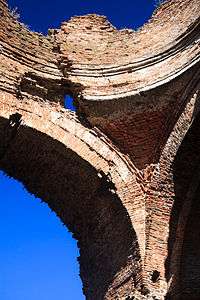Chiajna Monastery
| Chiajna Monastery | |
|---|---|
 | |
| Basic information | |
| Location | Giulești, Bucharest, Romania |
| Geographic coordinates | 44°28′45.22″N 25°59′53.06″E / 44.4792278°N 25.9980722°ECoordinates: 44°28′45.22″N 25°59′53.06″E / 44.4792278°N 25.9980722°E |
| Affiliation | Eastern Orthodox |
| Ecclesiastical or organizational status |
Monastery (since 2008) |
| Status | Active |
| Patron | Saint John Jacob Hosevite |
| Architectural description | |
| Architect(s) | Johannes Rathner |
| Architectural type | Church |
| Architectural style | Neoclassical |
| Founder | Nicholas Mavrogenes |
| Groundbreaking | 1780 |
| Completed | 1790 |
| Length | 43 m |
| Height (max) | 17 m |
| Materials | Brick |
Chiajna Monastery is the name of a ruined church situated on the outskirts of Bucharest, which is the subject of many legends, including the story that it is cursed.[1] The information center Giulești Park is devoted to the upkeep and protection of the building, which is a national heritage site.
History

Construction began during the reign of Alexander Ypsilanti (1774–1782) and was completed by the Phanariote Nicholas Mavrogenes (1786–1790). It was built in neoclassical style, and was considered very large for that time: 43 meters long and 18 high, with walls 1 and 2 meters thick.[2]
The church was meant to be one of the most important places of worship for Romania, but that never happened. The monastery was abandoned during the plague in the reign of Alexander Ypsilanti.
Other sources say that work on the monastery began in 1792, but was abandoned during the time of plague, when the prince was Mihai Suțu.
The tower collapsed in the earthquake of 1977.
Legends
- Legend says that the church was bombarded by the Turks even before consecration. Reportedly, the Turks believed that the church was a military objective and tried to destroy it. Thus, all the documents within the church were burned, though the building itself remained standing.[2]
- Its great bell was cast into the Dâmbovița River waters and, according to locals, is heard pounding on full moon nights.[2]
- On the wall on the right from the entrance, in about the middle, a few feet high, detaching plaster formed in the appearance of a lady or angel, and some claim it resembles the Sphinx of Giza or Romanian Sphinx.
- Over the years, many disappearances have been reported in the monastery, especially of neighboring Roma people.
- There were two murders, one before and one after 1990.
Building today
The ruin is located in the immediate vicinity of the railway Bucharest - Craiova and near the final approach path to Bucharest airport, the traffic on these routes hastening its degradation. Some architects believe that the monastery can be restored, because a church built from scratch would cost much more.
In April 2011 the monastery was claimed by the church and it now has restoration plans for the site. The place is now bordered by a fence but access is free.
References
- ↑ The curse of Chiajna
- 1 2 3 "Manastirea din inima iadului". Q-Magazine (in Romanian). August 18, 2008. Retrieved December 9, 2012.
External links
- Bucurescu, Adrian (November 17, 2010). "Chiajna, o mânăstire pe un maidan". Timpul (in Romanian). Retrieved December 9, 2011.